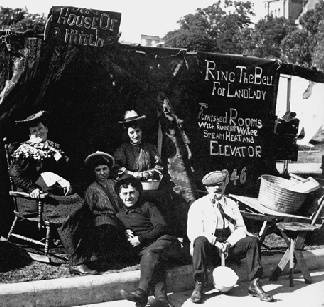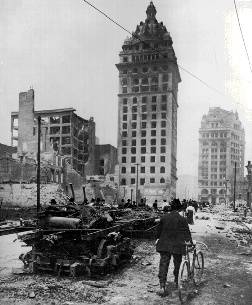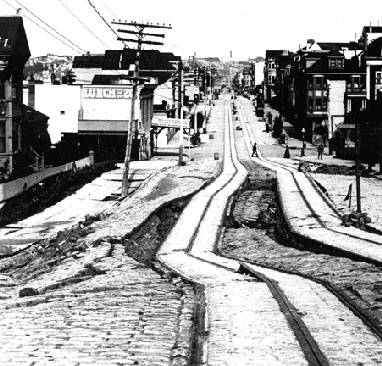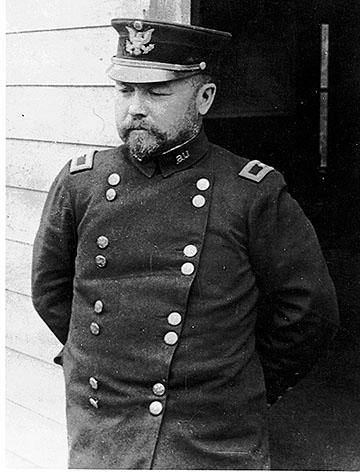April 18, 1906: EARTHQUAKE! FIRE!
Historical Essay
<iframe src="http://archive.org/embed/SanFranc1906_2" width="640" height="480" frameborder="0" webkitallowfullscreen="true" mozallowfullscreen="true" allowfullscreen></iframe>
Video: Prelinger Archive
1906 refugees
Photo: Greg Gaar Collection, San Francisco, CA
3rd St. Looking North after the 1906 Fire. The Call Building is in the center of the photograph.
Photo: Greg Gaar Collection, San Francisco, CA
Tracks twisted by the 1906 temblor.
Photo: Greg Gaar Collection, San Francisco, CA
PROCLAMATION by the Mayor
The Federal Troops, the members of the Regular Police Force, and all Special Police Officers have been authorized by me to KILL any and all persons found engaged in Looting or in the Commission of Any Other Crime.
I have directed all the Gas and Electric Lighting Companies not to turn on Gas or Electricity until I order them to do so. You may therefore expect the city to remain in darkness for an indefinite time.
I request all citizens to remain at home from darkness until daylight every night until order is restored.
I WARN all Citizens of the danger of fire from Damaged or Destroyed Chimneys, Broken or Leaking Gas Pipes or Fixtures, or any like cause.
--E. E. Schmitz, Mayor
Dated April 18, 1906
1905--A report made by the National Board of Underwriters says, "San Francisco has violated all underwriting traditions and precedents by not burning up. That it has not already done so is largely due to the vigilance of the Fire Department, which cannot be relied upon indefinitely to stave off the inevitable."
San Francisco boasts one of the largest and best-trained fire departments of any major city. The Department consists of 700 men manning eight fire stations which cover the entire city with the exception of the Chinatown ghetto. But Fire Chief Dennis Sullivan is continually thwarted by City Hall in his efforts to install necessary fire-fighting facilities. After persuading the War Department in Washington to give him stocks of explosives as well as a corp of engineers, Major Eugene Schmitz refuses to allocate the $1000 the War Department deems necessary for proper storage of the explosives at the Presidio.
The eastern end of the city--demand for real estate satisfied by reclaimed land filling in the bay with trash and refuse of all sorts. Union and Battery streets, south of Market, and around Montgomery. But the commercial buildings there were made of the same trash materials, constantly shifting upon treacherous foundations.
General Funston in San Francisco, 1906.
Photo: California State Parks
Earthquake shatters the main water pipelines rendering the Fire Department useless. Fire Chief Dennis Sullivan dies in the quake. Illegally and unilaterally Brigadier General Frederick Funston, commander of army troops in the city, puts San Francisco under martial law. A fireline is set up on Market Street. The area south of Market is resigned to the flames. Owner of the San Francisco Examiner, William Randolph Hearst, who is in New York when the earthquake hits, attempts to minimize the catastrophe in an editorial alongside of which is placed a retouched photograph of the great Baltimore fire of 1904.
Nearly all the city's hospitals are wrecked in either the earthquake or ensuing fire. At St. Luke's hospital, the operating theater collapses into the kitchen a floor below.
Gen. Funston sends in the first military demolition squad. The incompetence by which they dynamite buildings causes the outbreak of four new fires. Military squads are also sent in to protect against looting, shooting as many as a hundred suspects without warning or trial. Later in the day Mayor Schmitz issues a proclamation which is later declared unconstitutional.
Around 9:30 that morning, a woman in the working-class Hayes Valley area prepares breakfast. When she lights her stove, the quake-damaged chimney causes the walls of her house to ignite. This "ham and eggs" fire eventually burns up what is left of the City Hall area.
By midday fire reaches the Palace Hotel, one of the city's most esteemed landmarks which had housed such figures as Lilly Langtree, Oscar Wilde, Sarah Bernhardt, Isadora Duncan and Rudyard Kipling. Dynamite crews finally demolish the Daily News office, the final newspaper office still standing in the city. Troops are set up on the roof of the U.S. Mint building which had sustained only minor damage from the earthquake. Rumors are spread that an armed gang was planning to storm the mint and take its supply of coin and bullion valued at over $200 million.
By 1 pm, the first relief reaches the city, a single fire engine ferried across the bay from Oakland. The fireline now stretches from Pine to Washington Streets. A ban is issued on all indoor cooking; saloons are ordered shut and looters are being arrested on sight. Nearly all the city's hospitals are weakened by the quake.
6:00 pm: General Funston now attempts to encircle the fire in the heart of the city with systematic destruction of buildings. A drugstore at Clay and Kearny is blown up with black powder. A flaming mattress from the flat above is launched across the street setting fire to Chinatown. With Chinatown in flames, rats carrying bubonic plague now escape into other parts of the city. Rats as large as tom cats are reported. It is not until three months after the earthquake that bubonic plague is publicly acknowledged.
The Oakland Tribune runs a special edition headline "People Shot Down by Soldiers in Street of San Francisco". Union Square is set up as a temporary refugee camp. More permanent encampments are constructed at Golden Gate Park, the Presidio, and Dolores Park.
Men inside the U. S. Post Office beat down flames with mail sacks. To their credit not a single letter or package is lost in the great fire. There are frequent reports of looting of liquor stores by military patrols. One patrol breaks into Delmonico's Restaurant on O'Farrell Street and, looking for coffee, lights a fire which catches the roof, then sweeps up O'Farrell eventually setting ablaze the refugee camp in Union Square and the St. Francis Hotel.
At 11:00 that night, despite the efforts of Mayor Schimitz, sincere or insincere as they may have been, chaos still reigns in the streets. Evacuation, transportation and communication are haphazard at best. By 11:30 a line of regular soldiers stretches from Fort Mason down the length of Van Ness. The first food and medical supplies arrive in Oakland from Los Angeles. The city's magnificent libraries were all burned to the ground.
People begin piling personal effects along the sidewalks. Van Ness between Washington and Clay was piled with chairs, kitchen tables, etc., even an upright piano. People seem almost apathetic, due to a delayed state of shock. Bubonic plague is now affecting members of the white community and can no longer be dismissed as a "typically oriental disease." Gen. Funston prepares to blow a trench 50 yards deep the whole length of the south side of Van Ness down to Golden Gate Avenue through to upper Market Street and along the length of Dolores Street.
The Southern Pacific Railroad was one of the few businesses who acted in good faith during the disaster. People were ferried across the bay without charge and victims were given free passage to anywhere in North America, despite the looting of railroad goods and supplies by military patrols.
By late afternoon of the day following the quake Mayor Schmitz finally begins to wrest control of the city from General Funston, setting up a chain of command for goods and medical supplies. At last the wind begins to turn, blowing back across already devastated areas. At exactly midnight that night the fire breeches the last line of defense and leaps across Van Ness.
At 5 pm the next morning, the order came down from Mayor Schmitz that the dynamiting should stop. But the order comes too late to stop the exploding of a building on Green Street. The explosion ignites a previously untouched area and this new fire spreads along Green Street aided by a gale-force wind. 5 pm that afternoon Funston gives the order to resume the shelling of Van Ness Avenue against the direct orders of Mayor Schmitz in what seems to many to be senseless destruction. There are mounting reports of the excesses of the troops, including rape, indecent assault and grievous bodily harm.
At 8 pm that evening, Abe Ruef, the political boss controlling the corruption behind the scenes in the Schmitz administration, addresses the "Chinese question." He maintains that the orientals must not be allowed to return to the desirable location that had been Chinatown. The new Subcommittee on Relocating the Chinese attempts to find a "suitable" new sight. Ruef insists the sight must be inside the county so as not to lose the tax benefits. Vigilantes now begin to roam the streets, shooting even police officers. Chinatown is looted by soldiers and no questions are ever asked.
The turning point in the fire finally arrives at 5 am the next morning. By 6 o'clock the Mission District is declared safe. The Great Fire is officially out by 7:15 after 74 hours of burning.
{{#ev:archive|ssfQUAKE06|320}}
May 1906 film of Market St. Aftermath




